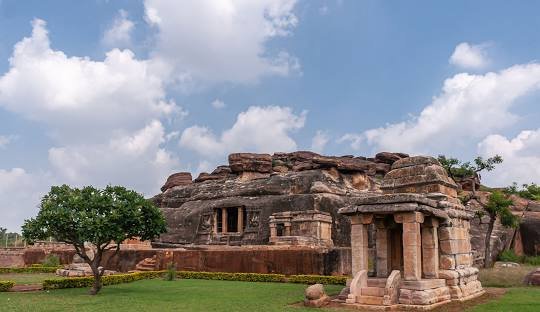The Ravanaphadi Rock Cut Shiva Temple, situated in Aihole, Karnataka, stands as a monumental testament to the early Dravidian style of Indian temple architecture. Known as the “Cradle of Indian Temple Architecture,” Aihole houses numerous ancient temples and remains a vital site for understanding the evolution of Indian architecture.
Key Highlights of Ravanaphadi Rock Cut Shiva Temple
Architecture
Carved out of a massive rock in the 6th century CE, the Ravanaphadi Temple features a minimalistic yet aesthetically rich design. The sanctum (garbhagriha) enshrines a linga, symbolizing Lord Shiva. This rock-cut style exemplifies early Indian architectural approaches, where temples were hewn directly from the natural rock face rather than constructed piece by piece.
Historical Significance
As the former capital of the early Chalukya dynasty, Aihole played a central role in shaping architectural innovations. The Ravanaphadi Temple is one of the earliest instances of rock-cut architecture in the region and marks a transitional phase from simpler rock-cut caves to more elaborate temple structures that began emerging in South India.

Connection to Vedic Mythology
The temple’s name, Ravanaphadi, connects to the legendary Ravana, the king of Lanka from the epic Ramayana. According to local tradition, it is believed that Ravana worshipped Lord Shiva here. This association adds to the temple’s cultural and religious significance, linking it to India’s epic narratives and devotional history.
Intricate Sculptural Details
The temple is adorned with intricate carvings and sculptures typical of Chalukyan artistry, depicting various deities and symbolic motifs. The simplicity of its design, blended with the natural rock formations, creates an aesthetic balance that reflects the early stages of temple art in the Indian subcontinent.
A Cultural Treasure
Recognized as part of a UNESCO World Heritage Site, Aihole, alongside nearby Badami and Pattadakal, holds immense historical importance for its remarkable collection of ancient temples. These sites collectively demonstrate the evolution of Indian temple architecture, from rock-cut structures to free-standing temples.
Tourism and Visitor Attraction
The Ravanaphadi Temple attracts historians, architects, and tourists keen on exploring the roots of Indian temple architecture. Its serene, natural setting combined with artistic mastery offers visitors a profound experience of ancient Indian spirituality and architectural brilliance.
Conclusion
The Ravanaphadi Rock Cut Shiva Temple stands not only as an architectural marvel but also as a significant cultural symbol of ancient India. Visiting this temple provides a unique glimpse into the early Dravidian architectural style, the historical legacy of the Chalukyas, and the rich cultural heritage of Aihole. This temple is a must-visit for those interested in history, mythology, and Indian architecture.













+ There are no comments
Add yours